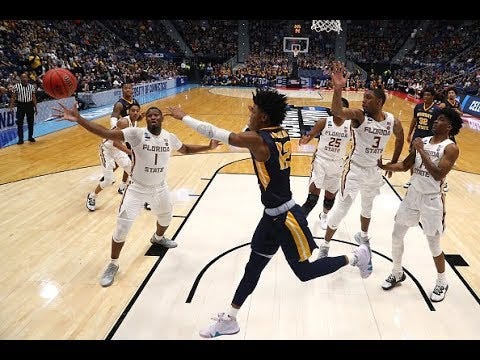Mid-Major Monday: Cinderella in the NBA
Mid-major alumni highlighted the opening weekend of the NBA Playoffs.
Since first getting basketball as a boy, I loved the NBA and college game pretty much equally. Media of both the social and traditional varieties sometimes suggests my demographic is a myth, but I’d venture to guess there’s a fair number of us.
I feel just as confident that the majority of us concede — occasionally, to the point of it coming off as groveling — that the NBA is of exponentially higher talent level and skill. What I love about college basketball isn’t anything objectively better in how the game’s played, but rather personal and subjective perspectives; things like enjoying how the rules and thus strategies are different from the pros, and the community bond college teams share with campuses.
College basketball does do one thing objectively better than the NBA, or any other sport: the postseason. March Madness has grown into a cultural phenomenon that I contend trails only the Super Bowl within the zeitgeist, surpassing the World Series within the last decade.
March Madness’ identity and popularity comes from its all-day, opening-weekend marathon. In recent years, the NBA has done as well as it possibly can in emulating that formula, tipping off with every series played out over two days.
Replicating the drama of the NCAA Tournament, even with the wall-to-wall format, isn’t feasible with series of seven games. However, the introduction of the play-in tournament gave this year’s NBA Playoffs an appetizer with a pinch of March Madness seasoning.
The last of the play-in games combined this element of what makes the Big Dance so unequivocally captivating with another key ingredient to the Madness: underdogs shining on the big stage.
Now, the NBA Playoffs provide plenty of underdog moments in the way our Mojave Desert friends use the term, but as far as recreating the Cinderella magic of March? The NBA postseason is designed specifically not to, as the more skilled and more talented team is at a decided advantage over seven games, regardless of seeding.
The NBA Playoffs have produced Cinderella stories, just considerably fewer than the NCAA Tournament. A parallel to the Grind City Grizzlies or We Believe Warriors emerges every March, sometimes in multiples.
What’s more, NBA Cinderellas are Cinderellas insomuch as they’re teams made up of well-paid professionals in the top 0.00001% of all people to touch a basketball, matched up opposite slightly better assembled rosters of well-paid professionals in the top 0.00001% of basketball players worldwide.
NCAA Tournament Cinderellas are typically teams representing universities with considerably smaller athletic budgets, far fewer undergraduates, and assorted other disadvantages.
For a single opportunity, however — corny as it may seem in a cynical time, in One Shining Moment — those teams get 40 minutes to beat an opponent with every advantage. That emotional element is the soul of March Madness that cannot be replicated, existing almost as a manifestation of the David vs. Goliath parable so many of us were read as children.
Occupying that demographic of people who love college basketball and the NBA equally, I bring that emotional connection over when watching the pros. And beginning with the final play-in game, Memphis-Golden State, these Playoffs gave me a taste of March.
Murray State’s Ja Morant battling it out opposite Davidson’s Steph Curry — who played perhaps the greatest NCAA Tournament that didn’t result in a Final Four berth — brought two eras of mid-major, Cinderella legend together.
Morant’s introduction to many hoopheads came with his triple-double in the 2019 NCAA Tournament, 11 years after Curry nearly bombed Davidson all the way to the Alamodome.
Against both the Warriors and in Memphis’ upset win in Game 1 against the Utah Jazz, Morant was just as dominant as when he balled in the Ohio Valley Conference and the Big Dance. His finger-roll late to help seal the defeat of the Jazz actually brought me out of my chair.
Ditto some of the shots Damian Lillard buried in Portland’s Game 1, road win over Denver.
Lillard never got the March stage at Weber State, which arguably makes his NBA success all the more of a Cinderella story than Morant’s immediate impact. Morant generated some modest, albeit existent chatter of going No. 1 in 2019’s NBA draft, coming out of a veritable mid-major power.
Morant was Murray State’s second lottery pick of the 2010s after Cameron Payne, whose own Game 1 experience came to an abrupt end Sunday with an ejection in the Suns’ win over the Lakers. Murray State’s pro-basketball history goes all the way back to the NBA’s infancy, when Jumpin’ Joe Fulks emerged as the league’s first high-volume scorer.
Before Lillard’s selection at No. 6 in 2012, Weber State hadn’t had a player drafted since 1985 — and only six alumni log minutes in the league prior.
Lillard didn’t make it to the NBA with a signature March performance, but backcourt mate C.J. McCollum makes up for it. McCollum going for 30 points in a 15-over-2 upset of Duke in 2012 carries immeasurable cachet with college basketball fans.
Elsewhere in these NBA Playoffs, the Los Angeles Clippers might have dropped Game 1 to Dallas, but their tandem of Mountain West Conference stars ensures the series ain’t over. San Diego State product Kawhi Leonard’s takeover of the last traditional NBA Playoffs ranks among the very best individual postseasons in my time following the game.
All this mid-major magic at the forefront of this NBA postseason sparks exciting possibilities for the future of college basketball. Another generation of playoff stars may currently be on the rosters of those programs that can only garner national attention in March.



